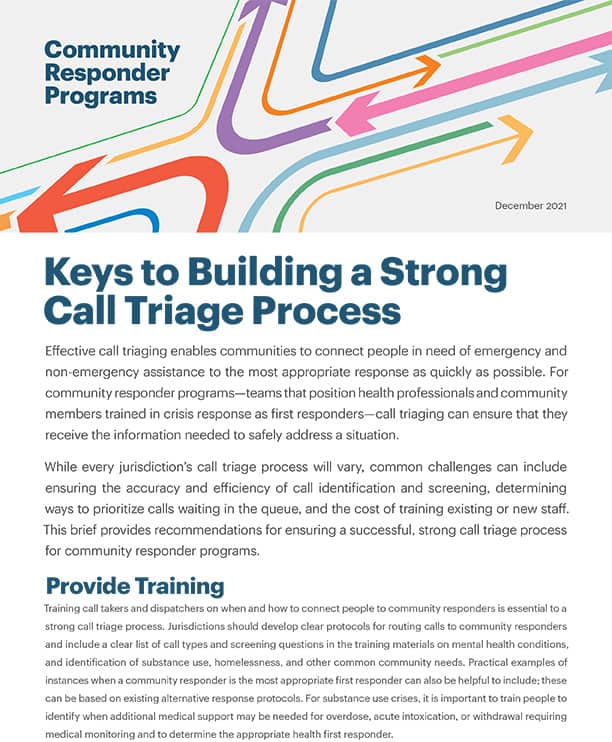Community Responder Programs: Keys to Building a Strong Call Triage Process
Effective call triaging enables communities to connect people in need of emergency and non-emergency assistance to the most appropriate response as quickly as possible. For community responder programs—teams that position health professionals and trained crisis staff as first responders—call triaging can ensure that they receive the information needed to safely address a situation. This brief provides recommendations for ensuring a successful, strong call triage process for community responder programs. Photo by RODNAE Productions via Pexal
Effective call triaging enables communities to connect people in need of emergency and non-emergency assistance to the most appropriate response as quickly as possible. For community responder programs—teams that position health professionals and community members trained in crisis response as first responders—call triaging can ensure that they receive the information needed to safely address a situation.
While every jurisdiction’s call triage process will vary, common challenges can include ensuring the accuracy and efficiency of call identification and screening, determining ways to prioritize calls waiting in the queue, and the cost of training existing or new staff. This brief provides recommendations for ensuring a successful, strong call triage process for community responder programs.
Provide Training
Training call takers and dispatchers on when and how to connect people to community responders is essential to a strong call triage process. Jurisdictions should develop clear protocols for routing calls to community responders and include a clear list of call types and screening questions in the training materials on mental health conditions, and identification of substance use, homelessness, and other common community needs. Practical examples of instances when a community responder is the most appropriate first responder can also be helpful to include; these can be based on existing alternative response protocols. For substance use crises, it is important to train people to identify when additional medical support may be needed for overdose, acute intoxication, or withdrawal requiring medical monitoring and to determine the appropriate health first responder.
Training should also incorporate implicit racial bias sensitivity training. Without it, call takers and dispatchers may be more likely to triage calls from certain individuals—particularly ones involving Black, Indigenous, and People of Color (BIPOC) community members—to police instead of community responders due to stereotypes or misconceptions. Most discretion-based diversion programs, for example, show persistent racial disparities in who is diverted,1 often resulting in BIPOC being pushed further into the criminal justice system. The same may be true for community responder programs unless deliberate effort is made to correct for racial bias.
Build Trust
Call takers are accustomed to directing calls to police dispatch, so they may be hesitant to transition to a new approach using community responders. One way to gain their trust is to involve call takers in discussions about the design of the community responder program and what training they think can be beneficial. Providing them with opportunities to learn more about screening questions for community responder programs and the effectiveness of the program can help ease any concerns call takers may have about directing calls to police alternatives. In-person meetings and coordinated training between call takers, community responders, police, fire, emergency medical services (EMS), and external call center staff can also help build trust.
Another way to build trust among staff normally involved in call triage (e.g., dispatch, officers, EMS, health providers, etc.) is to educate them on the safety record of existing community responder programs. Often, there are misconceptions that mental health and substance use crisis calls are inherently dangerous and likely to become violent. However, existing community responder programs have handled thousands of calls with no reported casualties or injuries, and only 1 in 500 calls requires emergency police backup.2
Regularly Monitor and Evaluate the Process
Collecting data on and regularly evaluating the call triage process will help jurisdictions understand if the community responder program is being utilized efficiently. If the program is not reaching the expected call volume, an oversight body can study if certain call types are not being used correctly or if there are other barriers preventing the program from reaching its potential. Any oversight body should also track data on race and which calls are being sent to community responders to identify any potential racial biases.
End notes
1. Traci Schlesinger, “Racial Disparities in Pretrial Diversion: An Analysis of Outcomes Among Men Charged with Felonies and Processed in State Courts,” Race and Justice 3, no. 3 (2013): 210–238.
2. Eugene Police Department Crime Analysis Unit, CAHOOTS Program Analysis (Eugene, OR: Eugene Police Department, 2021), https://www.eugene-or.gov/DocumentCenter/View/56717/CAHOOTS-Program-Analysis.
Project credits
Writing: Amos Irwin, Law Enforcement Action Partnership
Research: Amos Irwin, Law Enforcement Action Partnership
Project Manager: Amelia Vorpahl, CSG Justice Center
Advising: Jasmine Graves, Radical Imagination Strategies, and Sarah Wurzburg and Dr. Ayesha Delany-Brumsey, CSG Justice Center
Editing: Darby Baham, CSG Justice Center
Design: Michael Bierman
Web Development: eleventy marketing group
Public Affairs: Ruvi Lopez, CSG Justice Center
About the author

 New Hampshire Continues Justice Reinvestment Effort to Improve Conditions for People Who Are High Utilizers of Criminal Justice and Behavioral Health Systems
Read More
New Hampshire Continues Justice Reinvestment Effort to Improve Conditions for People Who Are High Utilizers of Criminal Justice and Behavioral Health Systems
Read More
 New Hampshire Commission Reviews Final Policy Recommendations to Reduce Reliance on Incarceration as Part of Justice Reinvestment Initiative
Read More
New Hampshire Commission Reviews Final Policy Recommendations to Reduce Reliance on Incarceration as Part of Justice Reinvestment Initiative
Read More
 Three Things to Know About New Jersey’s Groundbreaking Community Response Legislation
Three Things to Know About New Jersey’s Groundbreaking Community Response Legislation
In response to growing calls for police reform in New Jersey, particularly…
Read More













